Workflow for Configurations
Email Configuration
This section is useful for configuring settings for vuSmartMaps to integrate with the Email server for sending out notification emails.
These details may be configured with the Edit button.
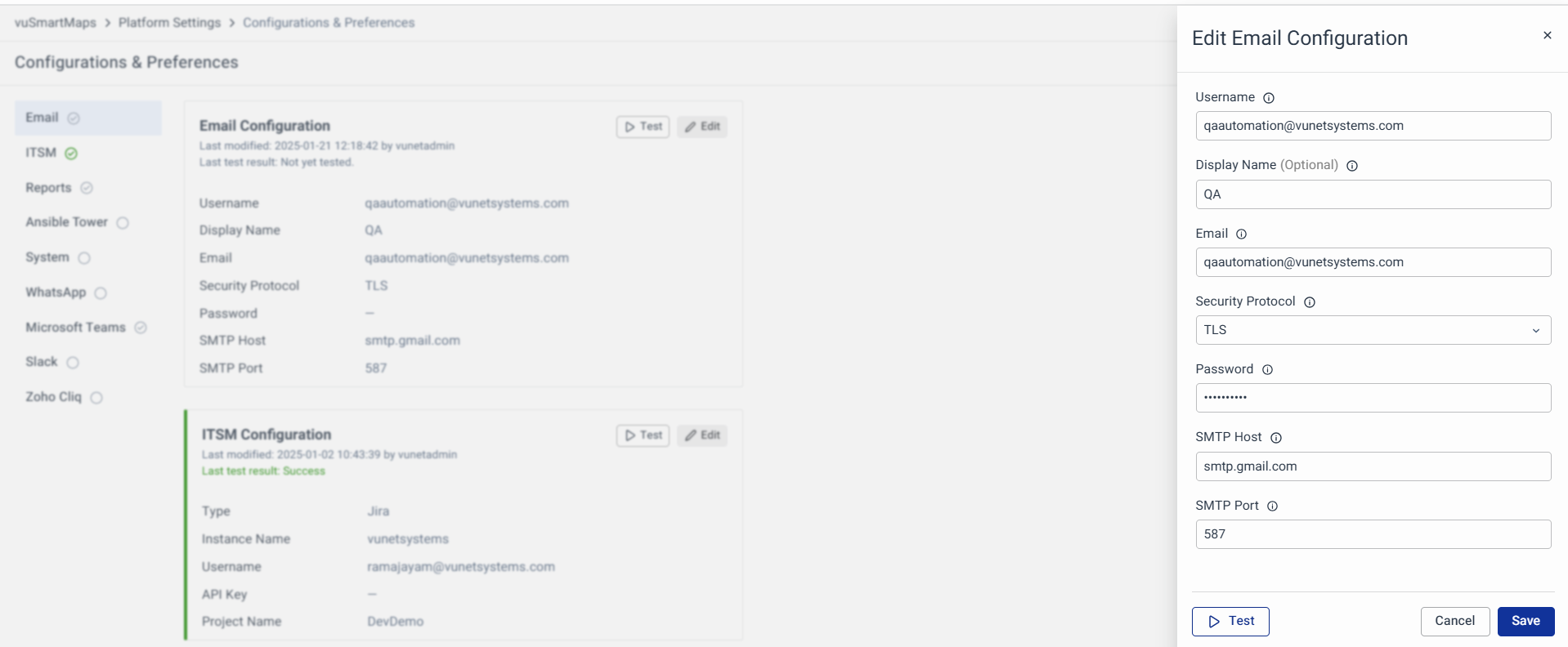
Email configurations on the following aspects can be configured with the vuSmartMaps platform:
- Username: User name to be used to login to the Email Server.
- Display Name (Optional): Name to be displayed.
- Email: Use this email address as the sender for emails generated by vuSmartMaps.
- Password: Password for authentication with Email Server.
- SMTP Host: SMTP Server Address.
- SMTP Port: SMTP Server Port.
- Security Protocol: Security protocol to be used for communication with Email Server.
- SSL
- TLS
- None
Testing Configuration
Click the Test button to send a test email to a specified email address. Enter the recipient email ID in the prompted modal. A success message confirms delivery, while a failure message provides error details for resolution.
ITSM Configurations
This section is useful for configuring Settings for vuSmartMaps to integrate with the ITSM system. This will be used to open tickets based on alert conditions and collect details of tickets present in the ITSM system.
These details may be configured with the Edit button.
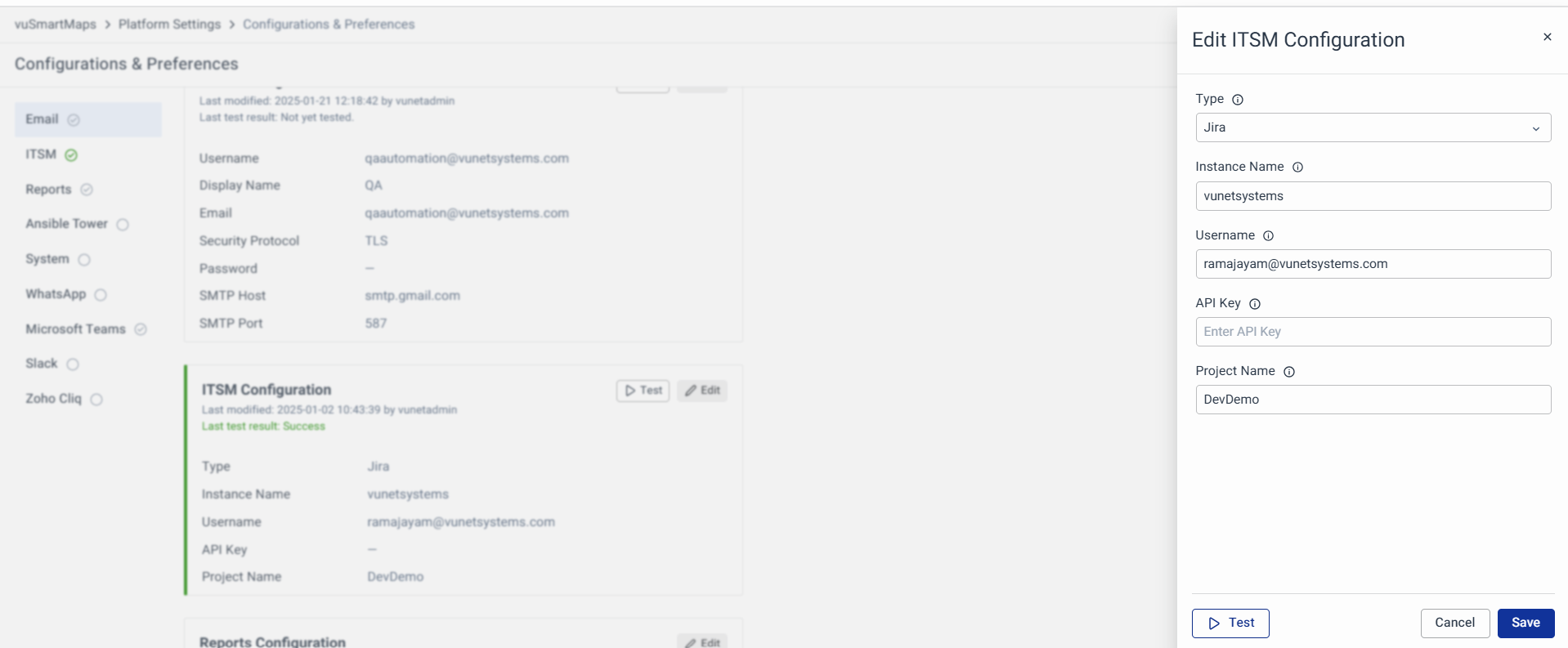
ITSM configurations on the following aspects can be configured with the vuSmartMaps platform.
- Type: Type of ITSM System. The following are the types supported with vuSmartMaps.
- None
- Service Now
- Server URL: Provide the server URL. For BMC Remedy provides both IP and port in
http://serverip:portformat - Instance Name: Instance name associated with Service Now ITSM systems.
- Username: Provide the username.
- Password: Password for this username.
- Server URL: Provide the server URL. For BMC Remedy provides both IP and port in
- OTRS
- Server URL: Provide the server URL. For BMC Remedy provides both IP and port in
http://serverip:portformat - Webservice Name: Provide the Webservice name.
- Username: Provide the username.
- Password: Password for this username.
- Queue: Configure the queue used for tickets within the OTRS system.
- Customer User: Configure the Customer user using which tickets are to be generated.
- Server URL: Provide the server URL. For BMC Remedy provides both IP and port in
- Manage Engine
- Server URL: Provide the server URL. For BMC Remedy provides both IP and port in
http://serverip:portformat - Username: Provide the username.
- Password: Password for this username.
- API Key: Provide the API key to be used.
- Matching Tags: Tags that will be used with Tickets.
- Server URL: Provide the server URL. For BMC Remedy provides both IP and port in
- Remedy
- Server URL: Provide the server URL. For BMC Remedy provides both IP and port in
http://serverip:portformat - Username: Provide the username.
- Password: Password for this username.
- First Name: Provide the First name.
- Last Name: Provide the last name.
- Additional fields used during ticket creation: Add the additional fields as key-value pairs, each separated by a comma. eg: Reported Source: Direct Input, Service_Type: User Service Restoration
- Ticket Create Fields
- Worklog Update Fields
- Server URL: Provide the server URL. For BMC Remedy provides both IP and port in
- Jira
- Instance Name: Provide the instance name of your Jira account. This should be the subdomain where your Jira instance is hosted, such as yourcompany.atlassian.net. Here, the instance name is yourcompany.
- Username: Specify the username of the account that will authenticate requests to the Jira API. Ensure this user account has the necessary permissions to create tickets in the designated Jira project. Mostly it is an email address.
- API Key: The API Key is a unique token generated by the user, typically corresponding to the user’s email address. This key functions as the authentication token for API requests, ensuring secure access to the API.
- Project Name: Specify the name of the Jira project where tickets will be created. This ensures that tickets generated by the alert engine are directed to the appropriate project within your Jira instance.
note
All the Jira tickets will be created in the project you are specifying, and that project must be able to allow the ticket type as BUG.
Testing Configuration
Click the Test button to validate the configuration (limited to JIRA ITSM). For Jira, a test ticket is created to ensure a successful connection. Errors, such as permission issues or missing fields, are displayed if applicable.
Reports Configurations
With this configuration, the user can provide the date time format in which the date fields of the report need to be displayed. The default format for this configuration is DD/MM/YYYY hh:mm:ss
Reports configurations on the following aspects can be configured with the vuSmartMaps platform.
- Date Format: The format for the Date field in Reports.
These details may be configured with the Edit button.
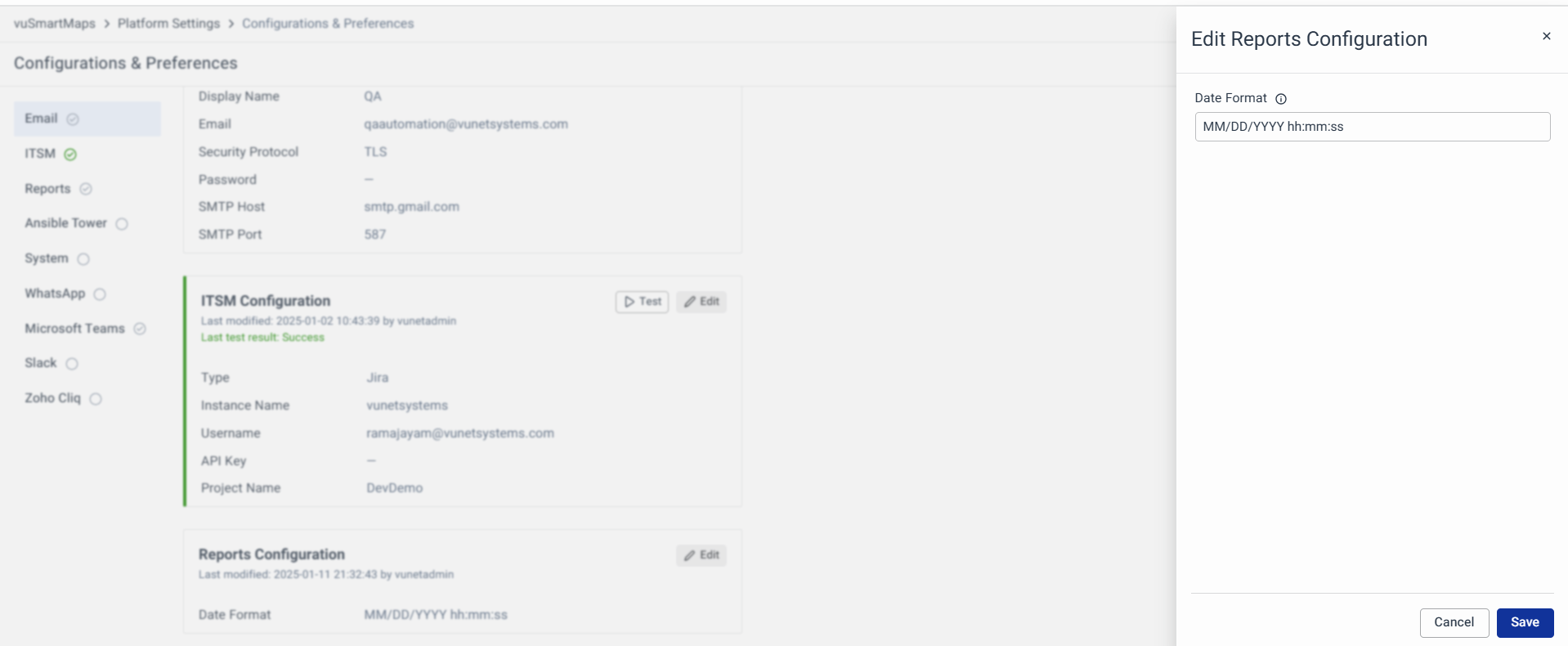
Ansible Tower Configurations
In vuSmartMaps, Ansible Tower integration is a powerful feature that allows you to manage and execute Auto Remediation jobs seamlessly through its REST API interface. While this feature is not yet available in the current release, it will be implemented in a future release, enhancing the overall automation process.
To configure your Ansible Tower configurations and take advantage of this feature when it becomes available, follow these steps:
- Navigate to the Ansible Tower Configurations section on the Configurations & Preferences landing page. The Configurations can be configured in the modal by clicking on the Edit button.
- Fill in the details on the following aspects:
- URL: Provide the correct URL. For Auto Remediation provide both IP and port in
http://serverip:portformat - Username: Provide the username
- Password: Password for this username
- URL: Provide the correct URL. For Auto Remediation provide both IP and port in
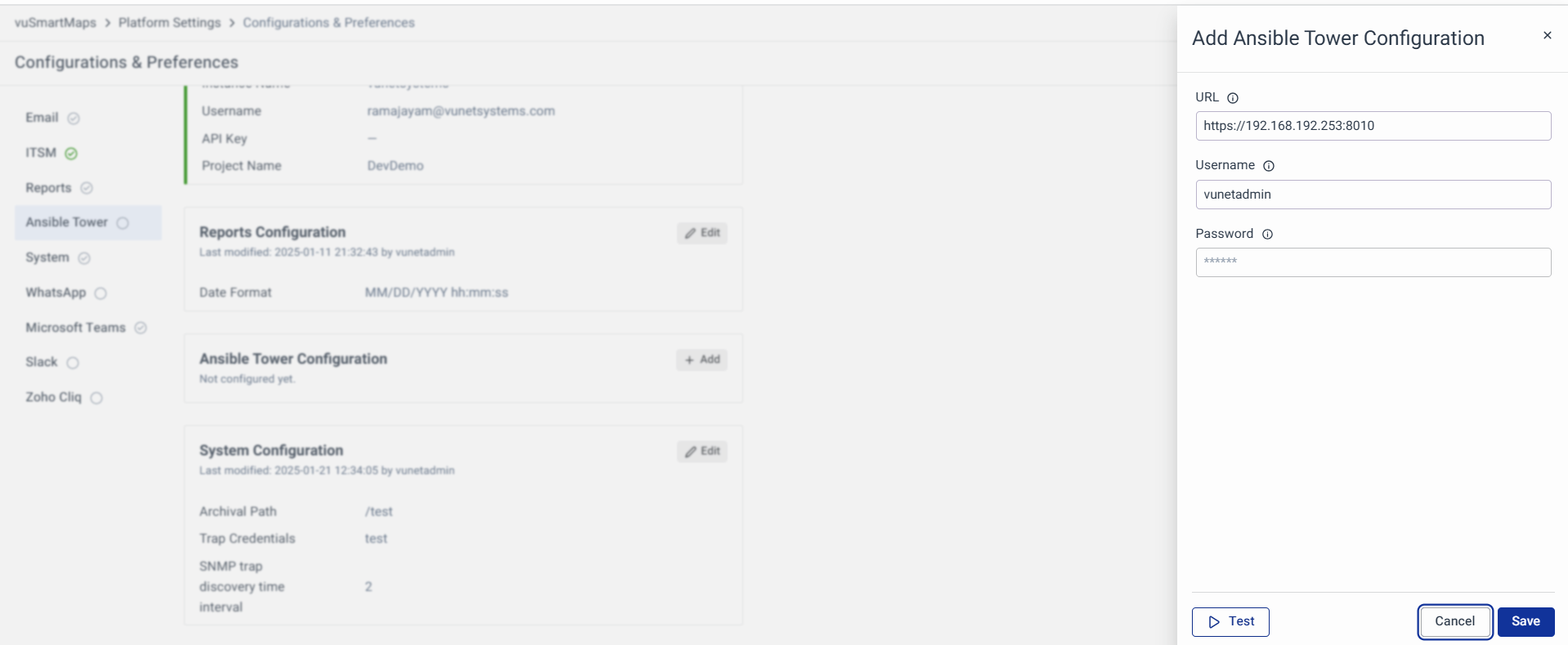
- Click on the Save button to apply these configurations.
Testing Configuration
Click Test to check the connection and credentials. Successful tests display a confirmation message, while failures show connection, response, or authentication errors.
System Configurations
System configurations on the following aspects can be configured with the vuSmartMaps platform.
- Archival Path: Full path where index archives are to be stored in the Analyser.
If nothing is provided, the default value of /data/vunet-backups will be used.
- Trap Credentials: Credentials to be used by SNMP trap-based discovery.
Should be in this format (separated by comma & colon); type-of-credential:credential-name; For Ex snmp:cred1, snmp:cred2
- SNMP trap discovery time interval: Time interval for SNMP Trap based discovery; Polling interval, in minutes, to be used to check for IPs to discover in SNMP trap data.
Click Edit to modify settings.

WhatsApp Configurations
Alerts created on the platform are sent to multiple notification channels including WhatsApp. The Platform uses the official WhatsApp business API to send notifications. This is a one-time configuration. This doesn’t need to be updated for each and every alert rule unless there is a need to update. The below three fields for WhatsApp Configurations can be updated on the Configuration & Preferences page:
- Phone number ID
- Access token
- The JSON payload sends a template message, according to the template configured with WhatsApp.
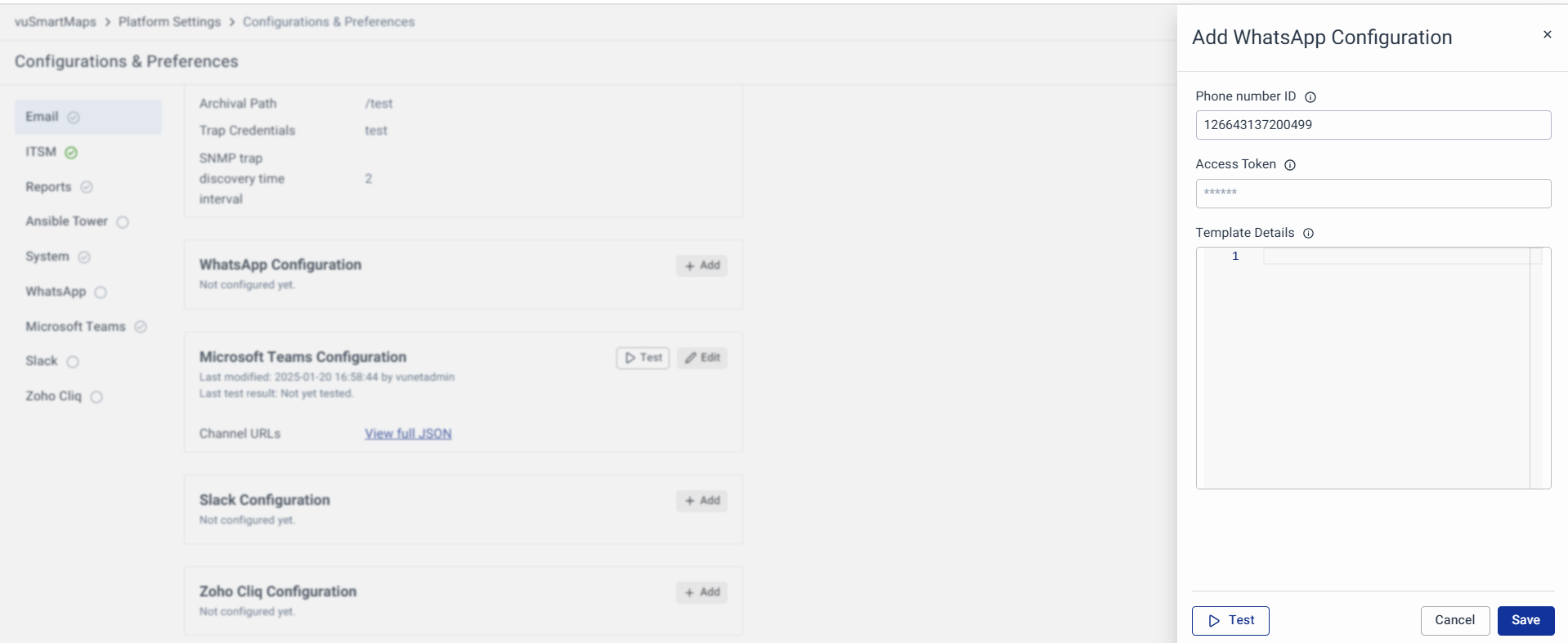
Refer to WhatsApp Integration for the advanced settings for creating and configuring Whatsapp business API with Meta.
Testing Configuration
Click Test to enter a phone number for testing. The system verifies the configuration and sends a test message. Success confirms message delivery, while failure provides error details for resolution.
Microsoft Teams Configurations
Alerts created in the platform are sent to multiple notification channels including MS Teams. For Each addition of incoming webhooks to a channel, it will generate a unique URL. These URLs are then added in the Configurations section as a JSON with the channel name as key and URL as value.
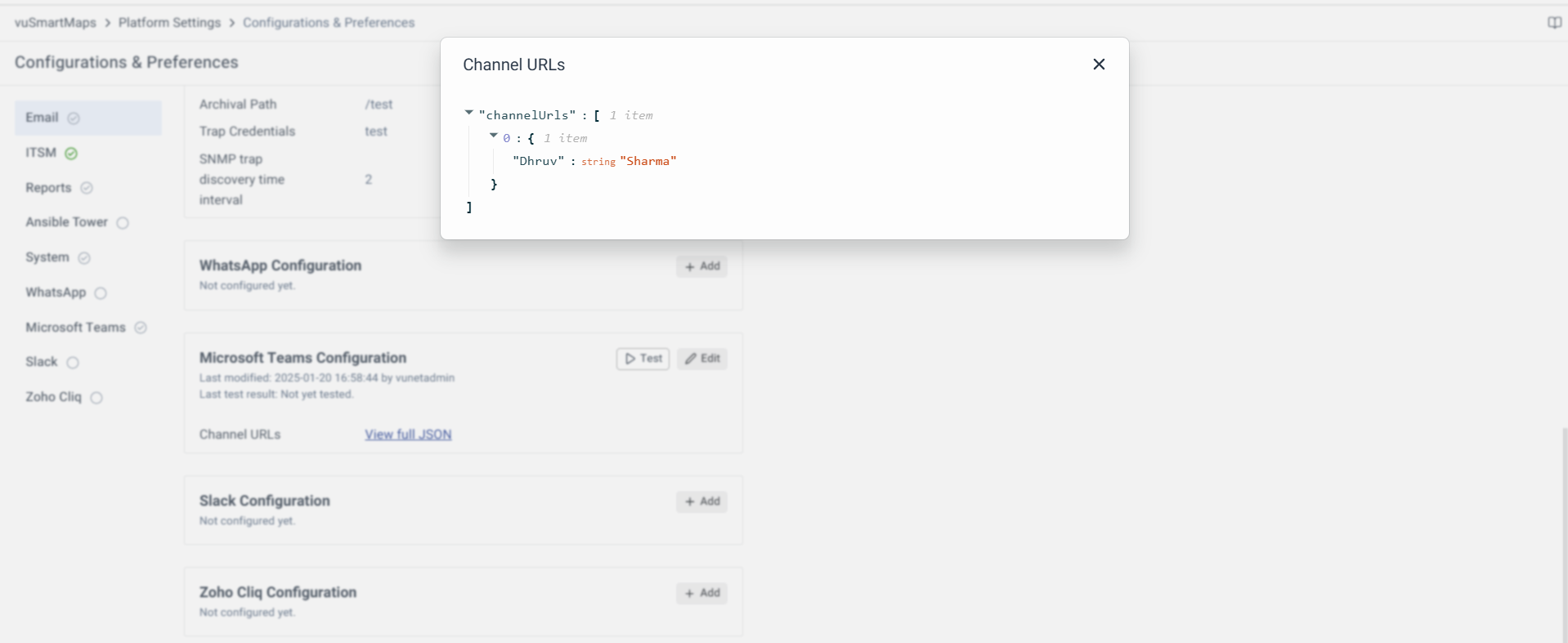
{
"General": "https://vunetsystems.teams.com/message/channel/general",
"Priority-alerts": "https://vunetsystems.teams.com/message/channel/priority-alerts"
}
Refer to MS Teams Integration for the advanced settings for configuring the Webhook connector and creating the message template.
Testing Configuration
Click Test to validate the URL and send a test message. Success confirms message delivery, while failures display errors for invalid URLs or channel names.
Slack Configurations
To configure alerts from the platform to be sent to your Slack workspace, you need to generate an API token. Insert this token in the Slack Configurations. Once this integration is in place, your platform alerts will be seamlessly relayed to your chosen Slack channels, ensuring efficient communication and timely notifications for your team.
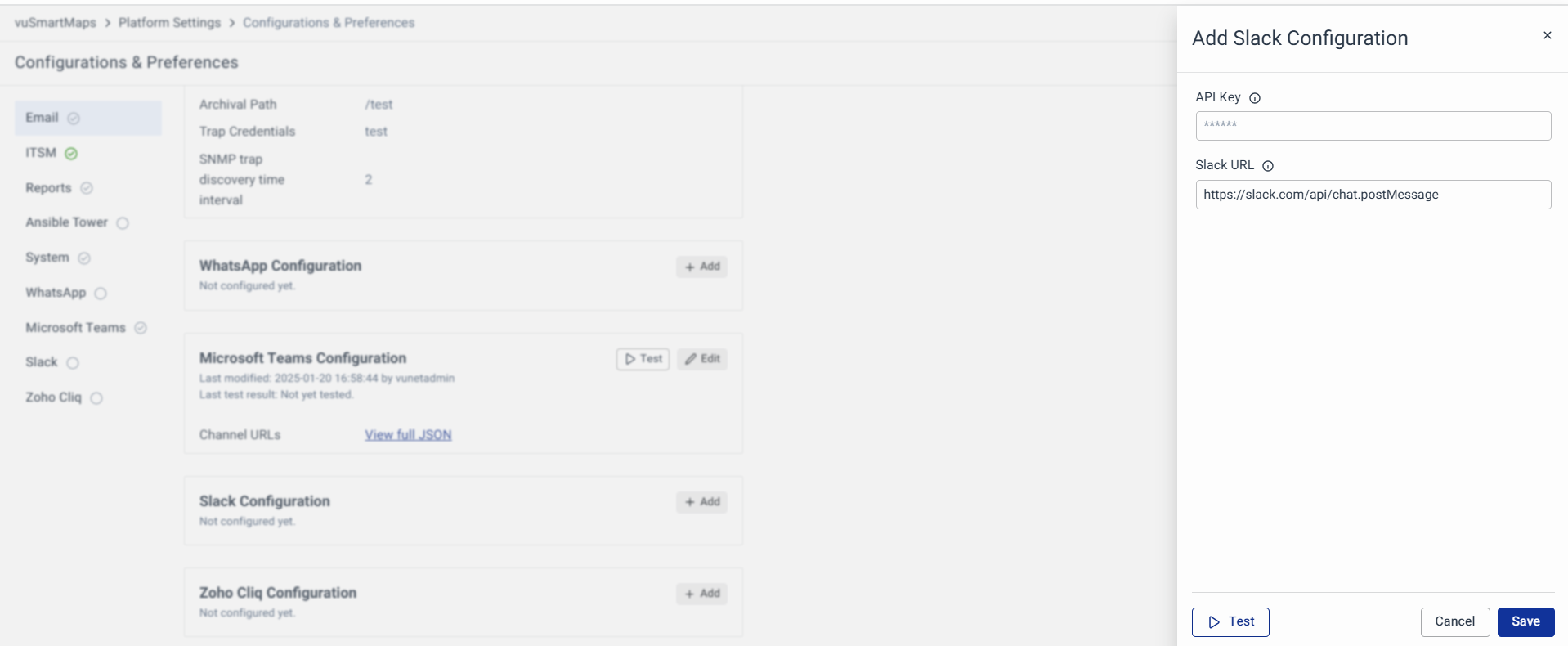
Refer to Slack Integration for the advanced settings for configuring the Slack App and creating the message template.
Testing Configuration
Click Test and enter a Slack channel name. The system sends a test message. Successful tests confirm message delivery, while failures display errors for invalid API keys or channel names.
Zoho Cliq Configurations
Alerts from the platform can be sent to various notification channels, including Zoho Cliq. When a webhook token is generated for a channel, the URL, along with the webhook token, is added in the Configurations section as a JSON object. The channel name serves as the key, and the URL with the webhook token is the corresponding value.
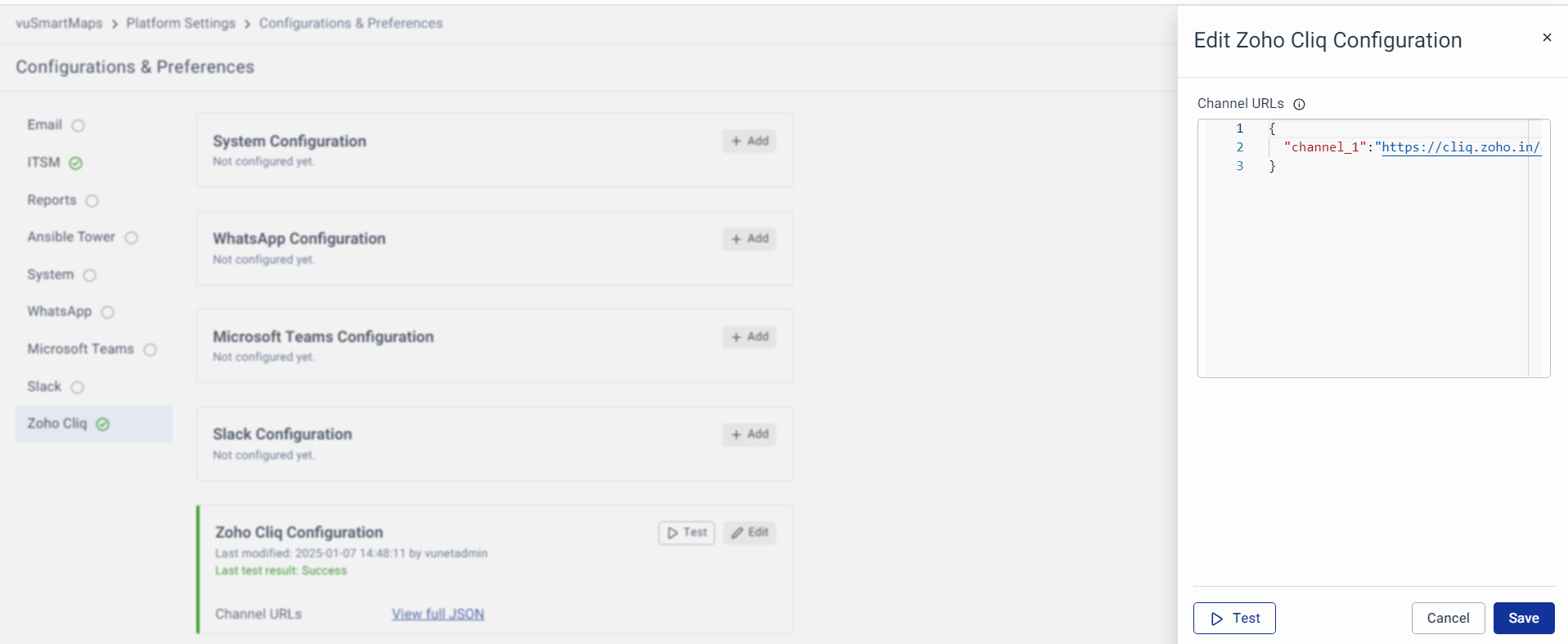
Example JSON:
{"vusmartmaps-alerts":"https://cliq.zoho.in/company/60032630000/api/v2/vusmaps-alerts/message?zapikey=1001.2413906c4fbaf6a48eafc9bb9ce74b46.baf9269384b2f2kw9shd83vbe9wbw8"} |
Breakdown of the example JSON:
- Channel's Unique Name
- In this example, the Channel's Unique Name is
vusmartmaps-alerts.
- In this example, the Channel's Unique Name is
- API Endpoint URL
- The API Endpoint URL is:
https://cliq.zoho.in/company/60032630000/api/v2/vusmaps-alerts/message?
- The API Endpoint URL is:
- Webhook Token
- The Webhook Token for authentication is:
zapikey=1001.2413906c4fbaf6a48eafc9bb9ce74b46.baf9269384b2f2kw9shd83vbe9wbw8
- The Webhook Token for authentication is:
For instructions on retrieving the Channel's Unique Name, API Endpoint URL, and details on generating a Webhook Token, please refer to Zoho Cliq Integration.
Testing Configuration
Click Test to validate the URL and send a test message. Success confirms message delivery, while failures display errors for invalid URLs or channel names.
